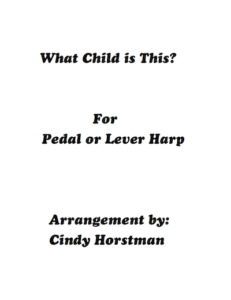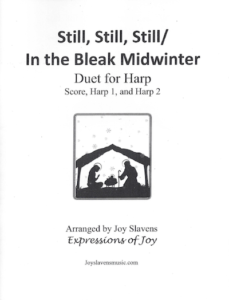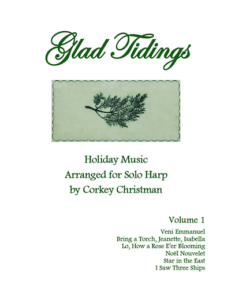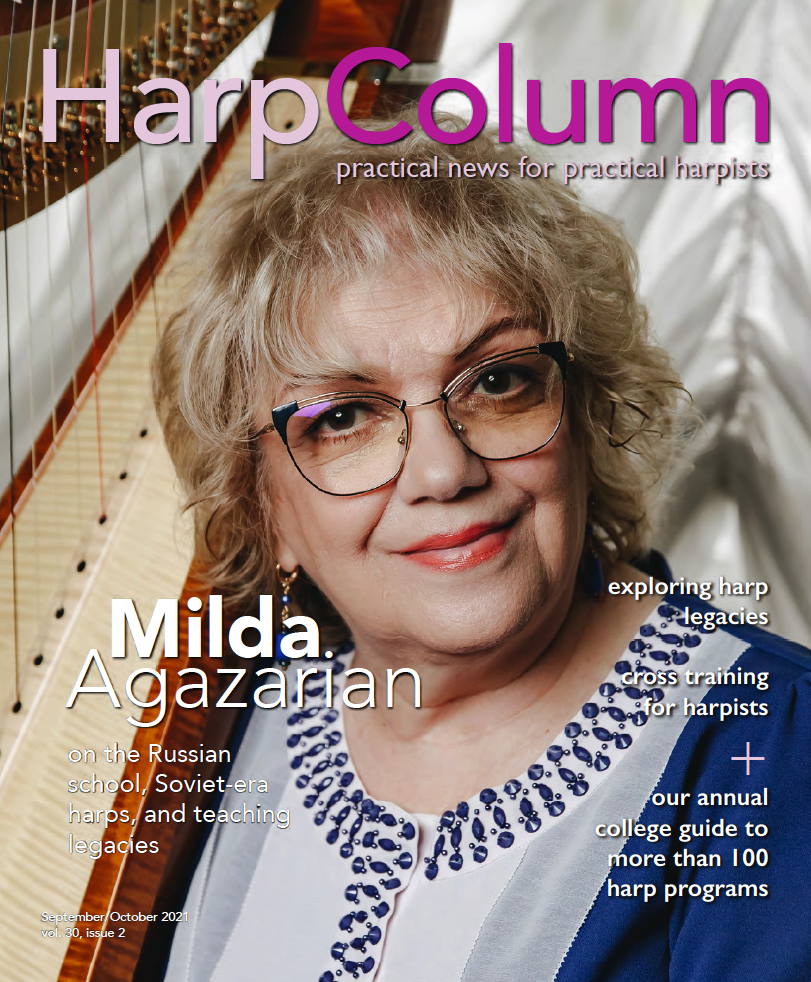It’s time to start planning for the holidays and keeping our fingers crossed that we will be performing in person once again.

Cindy Horstman has written an arrangement of “What Child Is This?” for pedal or lever harp. It is in A minor and both pedal and lever harps set the F-sharp for the duration of the piece.
The first and third verses are the same with an interpretive second verse. The intro is repeated as an interlude between verses. The stride bass pattern provides a gentle strumming effect in the left hand for accompaniment. It has Horstman’s signature jazzy sound. Pedal changes are notated in the center of the staff. There are no lever changes indicated, but fortunately the changes involve the same levers—the third-octave G in all verses and one second-octave G in the second verse—so you shouldn’t miss them if you read ahead.
Most fingering is provided. Intermediate players should be able to sightread the music. It makes a useful addition to your library, especially since this can be played year round as the oft-requested “Greensleeves.”

Joy Slavens has arranged a medley of “Still, Still, Still” and “In the Bleak Midwinter” for two harps. It can be played on pedal harp or lever harps tuned to E-flat. There are no pedal or lever changes throughout the duet and it is sight-readable for intermediate players. This self-published music (joyslavensmusic.com) includes the full score as well as separate parts for harps 1 and 2.
There is a four-measure intro that’s also used as a short interlude between the two melodies and as a tag at the end. There are two verses of “Still,” followed by two verses of “Midwinter,” followed by one more verse of the first piece. Both parts get to take the melody, though harp 1 has it more. Harp 1 also gets to play the two scale glisses. Harp 2 has a little more arpeggiated accompaniment.
Page turns are very manageable. Rehearsal markings make practicing easier. This likable and playable arrangement would be a charming choice for a harp duo at a Christmas service or for a student recital.

Bill Van Patten has compiled and published a collection of holiday arrangements for pedal harp by his first teacher, the late Corkey Christman. There are six carols in this first volume titled Glad Tidings, and it is available through harpcolumnmusic.com. These are not the most common carols, and, while they are not difficult, they showcase Christman’s unique and distinctive style.
“Veni Emmanuel” has two verses, and the second features the melody in the left hand. “Bring a Torch, Jeanette, Isabella” moves the melody up an octave in the second verse. There are some harmonics, including double harmonics, in the left hand at the end. “Lo, How a Rose E’er Blooming” also moves the melody up an octave for the second and third verses. The third verse is probably the most challenging because of the triplets in the left hand accompaniment.
“Noël Nouvelet” is three pages and three verses, but it goes by so quickly that it seems like it’s over too soon. The sixteenth notes in the second and third verses and the grace notes in the third verse give it a light and airy feel. It could be played on lever harp. “Star in the East” has numerous pedal changes, all of them written below the staff. The second verse is an octave higher than the first and switches to a left hand melody, sometimes played in harmonics. Harmonics are used to end the piece. The last selection is “I Saw Three Ships,” and it’s a very creative and clever arrangement. There are six verses, and each one is slightly different. In the first three, it’s the left-hand accompaniment that is varied, either rhythmically or in chord voicing. In the fourth verse, the melody is an octave higher and the left hand plays eighth notes that come in off the beat. In the final two verses, there is sort of a call and answer effect with the melody starting out the first notes in the upper octaves and jumping to the lower octaves in the left hand to complete the phrase. This could be played on lever harp.
Most of these arrangements can be heard on Van Patten’s YouTube channel, and they are suitable for intermediate players.

Gary Schocker has a third volume of Christmas music published by Theodore Presser Company. To Touch Their Harps of Gold is a collection of more obscure or unknown carols, in spite of the subtitle, “22 Favorite Christmas Carols.” Although surely they are someone’s favorite carols, it is unlikely that most harpists or their audiences will be familiar with most of the tunes, but here’s your chance to treat your listeners to something new.
It is intended for pedal harp, but 12 of them can be played on lever harp tuned to E-flat with very minor adjustments, usually simply moving some of the lowest bass notes up an octave. Others can be played by changing the key, such as “Quem pastores laudavere” played in G major instead of G-flat, or “Jeg er så glad” played in A major instead of A-flat. “O Little Town of Bethlehem” has an occasional A-natural as an accidental, but it can be omitted for lever harp. Incidentally, this is not the tune that is widely known in North America. Instead, it is a melody that is popularly used in the United Kingdom.
One selection, “Dormi, dormi o bel bambin,” is presented in E major, but it will sound more sonorous on both pedal and lever harps if played in E-flat. This one also has a pesky page turn, but fortunately the last measure before the page turn can be played entirely in the right hand. It also has several meter changes from 4/4 to 5/4 to 6/8 and 9/8.
Most of the selections offer at least two verses of each carol, although in most cases, each verse is simply repeated or nearly identical. Notable exceptions include “Es wird scho glei dumpa,” which changes the left-hand accompaniment from the treble clef to the bass clef in a rocking pattern. “Jeg er så glad” offers the most variety with three verses that are each different, including a left-hand melody. “Pásli Ovce Valaši” changes key in three very short verses from F major to D-flat and back again.
Schocker must be a fan of harmonics, as he uses them frequently and effectively. There are several F-major glisses in “Leise rieselt der Schnee.” A few pieces have p.d.l.t. sections.
There is no fingering indicated, but all pedal changes are notated below the staff. The publisher did not include a table of contents, and there are no performance notes, which would have been a welcome addition for these lesser-known carols. The music is not difficult and is sightreadable for the intermediate to advanced player.

Heidi Lehwalder has joined the ranks of harpists writing books. Her contribution, A Harpist’s Guide to Effortless and Organic Playing is more a summation of her philosophy of playing and teaching than a strictly instructional book. She discusses everything from sitting at the harp to hand position, dynamics, memorization, and more. It is published by Vanderbilt Music Company, and there are 13 chapters with 52 pages of information. There are several photos to illustrate her points as well as some historic snapshots from her impressive career. She is clearly a follower of the Salzedo school, but non-Salzedo players will find similarities as well as differences. In fact, the non-Salzedo players may find this book sheds some light on the thought processes behind the Salzedo method. Just as in politics, finding some common ground helps us to understand and accept each other rather than alienate us.
I’ve never used the adjective “organic” to describe playing the harp, but in Chapter 6 Lehwalder defines it by writing, “the word effortless is synonymous with relaxed and organic.” While I still wouldn’t use the word to describe harp playing, I understand what she is trying to convey.
There are a few minor editing errors (e.g., a pesky homophone) but nothing too distracting, and the meaning is clear. It is a short and easy read offering insights into what may be a different approach from yours to playing and teaching, and, therefore, thought-provoking. •







